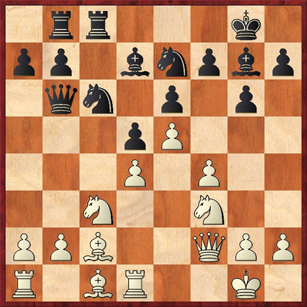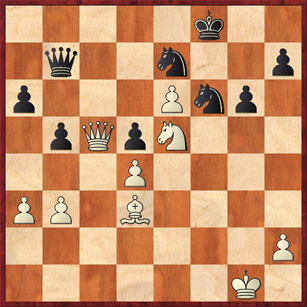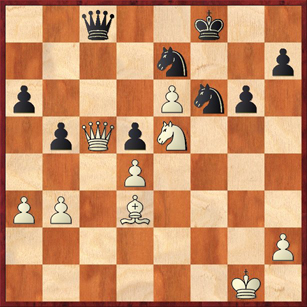Tortoise and Hare sat down to play a game of chess. (If you don’t like fables, “Tortoise” is me, Dana Mackenzie. “Hare” is an expert named Arthur Liou. The date was November 29, and the occasion was round five of the CalChess State Championship.)
After an opening where neither side got an advantage, Tortoise and Hare reached this position. Tortoise, who was playing White, had to decide on his 15th move.
Tortoise wrestled with his decision and agonized over it for a long time. What he wanted most of all was to complete his development. He remembered how Jesse Kraai says that good players solve the problem of their worst pieces before they go on any adventures. The bishop on c1 is suffering, and is clearly White’s worst piece. But Tortoise could not convince himself that 15. Bd2 or 15. Be3, sacrificing the pawn on b2, would be good. 15. b3 also did not look good because of the response 15. … Nb4, winning the white-squared bishop and exposing the sensitivity of the c-file. Tortoise toyed with the idea of 15. g4, but Jesse’s warning brought him back to earth. The only move he could find that seemed appealing was 15. Na4, with the idea of relocating to c5 and blocking the c-file. Also, chasing the queen away from b6Â would help with the development of the c1 bishop. The trouble with 15. Na4, however, was that Black could play 15. … Qc7, and after 16. Nc5 Nxd4 Black would win a pawn. However, this pawn sac looked at least somewhat promising, because White gains several tempi with 17. Nxd4 Qxc5 18. Be3 Qc7 19. Rac1 Qd8 (for example). Finally, after 22 minutes of thought and indecision, Tortoise thought to himself, “Heck with it. Nothing else is any good, so I’ll try it.” He moved the knight to a4.
We don’t know what Hare was thinking, unfortunately. However, he immediately played not 15. … Qc7, but 15. … Qd8. In this critical position he took only 10 or 15 seconds to make up his mind. Tortoise was dumbfounded. All that time he had spent analyzing the pawn sac and the other variations had been almost completely wasted, because his opponent had instantly played a move that Tortoise had considered inferior. But Computer, the arbiter of all things, says that 15. … Qd8 is not inferior at all!
In the fables they talk about Dumb Hare and Smart Tortoise. But here I think we may have a case of Smart Hare and Dumb Tortoise. Tortoise had chosen a good move, it’s true, but he had used a ridiculous amount of time doing it. Smart Hare had probably figured out what Tortoise was thinking about and said, “I’ll just play it safe and gain 22 minutes on the clock, which is better than accepting an unclear pawn sacrifice.” The result was that after 15 moves, Tortoise had used a whole hour while Hare had only used 10 minutes.
But later in the game, Hare’s quick decision-making got him into trouble. He schemed to move his own knight to c4, but went there too hastily and the knight just got chased away again with b3. Black’s pieces, once nicely organized, started to drift into passive positions because Hare did not have a plan any more.
Meanwhile, a funny thing was happening to Tortoise. He had been a little bit rattled by Hare’s quick moves earlier in the game, but now he was rather enjoying the fact that every time he moved, he would only have to wait 30 seconds or a minute, at most, to see Hare’s answer. The predictability of Hare’s moves — both the choice of move and the amount of time it would take Hare to choose it — allowed Tortoise to establish a very comfortable rhythm, and actually make some quick moves himself.
Just before the time control, at move 40, another crucial position was reached.
Tortoise had just played 39. Ne5, and now had 4 minutes on his clock to make his last move of the time control. As for Hare, he had used only 24 minutes of his time, and so he had 1 hour and 36 minutes left. But he was Hare, and Hares never take more than a minute. Besides, it’s obvious what Black wants to do here. He wants to trade queens, and so Hare quickly played 39. … Qc8??
According to Computer, the arbiter of all things, this was a catastrophic blunder, which makes Black’s disadvantage go from 0.8 pawns to oh, about 11.0 pawns.
But Tortoise, being a mere mortal, did not have access to Computer’s wisdom. He had 4 minutes to decide on his next move, and had no way of knowing this was a “White to play and win” situation. At first he intended to play 40. Qxc8 Nxc8, but then he realized that after 41. Nd7+ Ke7! Black can stop his e-pawn, and not only that the e-pawn will be indefensible. Better would be 41. Nc6, which cuts off the king and also has ideas of harassing Black’s queenside pawns with Nb8. This looked promising, but still it looked as if it would be a lot of trouble to win.
Tortoise’s clock was now down to 3 minutes. He was just about ready to play 40. Qc8, when suddenly he did a good thing. He thought, “Wait a minute.” Tortoises, of course, are fond of waiting a minute.
Tortoise thought, “Wait a minute. If Black’s key defensive move is … Ke7, why not play Nd7+ while the e7 square is still occupied, so that the king can’t go there?” Tortoise also remembered the ChessLecture he had given once on reversing the move order: if Move A (Qxc8) followed by move B (Nd7+) doesn’t work so well, try doing them in the opposite order.
As he did so, Tortoise started to get that tingly feeling that even Tortoises get when they see a game-changing move. After 40. Nd7+!, if Black moves his king to e1 or g8, he loses the f6 knight with check. If Black plays 40. … Kg7, then instead the e7 knight falls. And finally, if 40. … Nxd7, now White plays 41. Qxc8 Nxc8 42. ed, and White’s pawn (a “berserker pawn,” to recall another ChessLecture) cannot be stopped. It will promote on either c8 or d8, depending on what Black does.
Poor Hare could have thought about his next move for an hour and 36 minutes if he had wanted to, but fortunately he remained true to his principles, studied the position for less than a minute, and tipped over his king.
What is the moral of this little fable? Well, I’m not really sure. The moral of Aesop’s fable was, “Slow and steady wins the race.” But I’m not sure that is always true in chess. Fast and steady has some advantages. I especially like the fact that Hare did not agonize over his decisions in this game. On Tortoise’s 15th move he had a hard choice to make, and he agonized for 22 minutes. A lot of this time was just wasted — not on analysis but on indecision. Hare also had a hard choice to make between 15. … Qc7 and 15. … Qd8, but he had already made up his mind. Perhaps he had realized that they were about equally good, so it would not be worth his time to spend a lot of time deciding.
However, one thing I am sure of is that sometimes there are subtleties in chess that lie beneath the surface and that you cannot see if you always move in a minute or less. Maybe Computer, the arbiter of all things, can see them, but we mortals cannot. And so there are some times when it is a very good thing to pause before you make your move, take a deep breath, and say, “Wait a minute.”
P.S. Now that you know why 39. … Qc8 was a bad move, can you figure out what Black should have done instead?






{ 3 comments… read them below or add one }
same deal – I was taking 20 minutes per move, Renteria took 3 minutes tops for any move.
[Event “World Open, Under 2400 section”]
[Site “Philadelphia Sheraton, 17th and Race”]
[Date “2009.07.02”]
[Round “3”]
[White “Brian Wall”]
[Black “Jorge Renteria”]
[Result “1-0”]
[ICCResult “Black resigns”]
[WhiteElo “2202”]
[BlackElo “2361”]
[Opening “Sicilian: Najdorf, Lipnitzky attack”]
[ECO “B86”]
[NIC “SI.13”]
[Time “12:02:40”]
[TimeControl “40/1:55, G/55, 5 second delay throughout”]
1. e4 c5 2. Nf3 d6 3. d4 cxd4 4. Nxd4 Nf6 5. Nc3 a6 6. Bc4 e6 7. Bg5 Be7 8.
Qf3 Qa5 9. Bh4 Nbd7 10. Bb3 Nc5 11. O-O-O Bd7 12. Kb1 Rc8 13. Rhe1 b5 14.
Nf5 exf5 15. exf5 Nxb3 16. Bxf6 gxf6 17. Qe3 Qd8 18. Nd5
1-0 Black resigns
great post
play chess
online at chess
Hello, Hi, Hey, great article, post, blog, I, we love, like, loved, liked it !!!
{ 1 trackback }